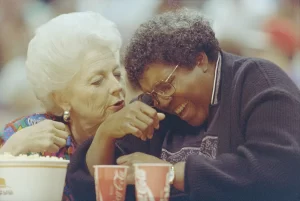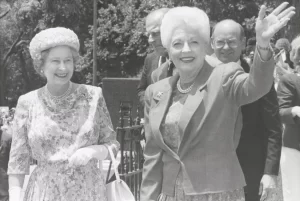Dorothy Ann Willis Richards (1933–2006) served as the 45th Governor of Texas from 1991 to 1995. A former teacher, county commissioner, and state treasurer, Richards became one of the most nationally recognized Democratic figures to hold statewide office in the late twentieth century. Her tenure as governor coincided with the growing strength of the Republican Party in Texas and a period of political, demographic, and institutional transition in state government.
Early Life and Political Rise
Ann Richards was born on September 1, 1933, in Lakeview, Texas, near Waco. She graduated from Baylor University in 1954 and later earned a teaching certificate from the University of Texas at Austin. In the 1950s and 60s, she worked as a social studies teacher and was active in Democratic Party organizing at the precinct and county level.
Her first elected office came in 1976 when she was elected Travis County Commissioner. She served two terms before running for statewide office. In 1982, Richards was elected Texas State Treasurer, becoming the first woman to win that office in over 50 years. During her tenure, she advocated for modernization of state financial management and implemented electronic systems to improve efficiency in treasury operations.
Her keynote speech at the 1988 Democratic National Convention elevated her national profile, and two years later, she entered the governor’s race to succeed outgoing Republican Governor Bill Clements.
1990 Gubernatorial Election
Richards won the Democratic nomination in 1990 after a contested primary and runoff. In the general election, she faced Republican nominee Clayton Williams, a businessman and political newcomer. The race drew national attention and became highly polarized. Richards won narrowly, receiving just under 50% of the vote.
Her victory marked the last time a Democrat would win the Texas governorship as of the early 21st century. It also represented the end of a long era of Democratic control, as Republican candidates steadily gained ground in down-ballot and statewide offices throughout the 1990s.
Governorship (1991–1995)
Richards took office on January 15, 1991. Her administration focused on a broad agenda that included ethics reform, criminal justice policies, and state government modernization.
One of her early legislative priorities was ethics reform, building on public dissatisfaction with perceived conflicts of interest in state contracting. The Ethics Commission was restructured, and financial disclosure laws were strengthened.
In the area of criminal justice, Richards expanded the prison system significantly to address overcrowding, while also supporting drug treatment and rehabilitation programs. Her administration implemented new substance abuse initiatives and expanded parole supervision infrastructure. These efforts coincided with a broader national shift toward tougher sentencing laws and growing concerns about recidivism.
She also supported appointments of women and minorities to state boards and commissions, increasing representation in agencies that had historically lacked diversity. Her judicial and executive appointments were often cited as a key legacy of her administration.

On fiscal matters, Richards worked with the legislature to pass a state budget during an economic downturn, navigating lower oil prices and revenue shortfalls without large tax increases. Her team pursued performance audits and sought to increase efficiency in agencies through staff restructuring and consolidation.
In public education, Richards supported the implementation of the Texas Education Agency’s accountability framework, building on reforms passed under previous administrations. She did not call for major structural changes but endorsed increased oversight and performance metrics.
Despite her visibility and popularity in certain urban and national circles, Richards faced growing opposition from a resurgent Republican Party. In the 1994 general election, she was defeated by George W. Bush, then a businessman and first-time candidate. Bush won with 53.5% of the vote, signaling a further shift in Texas’s political alignment.
Later, people close to Richards and her campaign, including Austin attorney and campaign advisor Jane Hickie and political consultant Jack Martin, disclosed that Richards’ enthusiasm for the governor’s job had waned, in part because of ongoing tensions with Lieutenant Governor Bob Bullock who, despite being a Democrat, had made it difficult for Richards to implement her agenda. Richards, though she may not have really wanted to serve a second term, felt she had an obligation to run. Robert Spellings, a friend, recalled a conversation that he had with Richards as they sat in his car in the driveway of the Governor’s Mansion discussing a second campaign:1
“Bush had not yet announced, but he was getting ready to. Ann says, ‘You know, Robert, this boy could beat me.’ And I said, ‘Well, Ann, you don’t have to run.’ And she said, ‘Oh, yeah, I’ve got to run. I owe too much to those people.’”
As a result of her ambivalence, Richards did not campaign as vigorously as Bush, who ran an energetic campaign with disciplined messaging focused on just four key issues. Reggie Bashur, a Republican political operative, remembers being “puzzled by Richards’s lack of drive for campaigning for reelection”2:
“Ann Richards, for reasons no one can understand today, did not run a very aggressive race for reelection. You know, if you go back, the records show that she made maybe one proposal the whole campaign—I think for teacher pay raises. She did not seem like she had the energy to run that race. This allowed Bush to become an accomplished campaigner. And on the plane, he said, ‘She’s supposed to be this celebrated campaigner—where is it? I don’t see her campaign. I think she is giving us a real opportunity to win.'”
Later Years

Following her defeat, Richards did not return to elected office but remained active in public speaking, media commentary, and advocacy work. She served on corporate boards and supported Democratic candidates nationally. In her later years, she also taught and lectured on public policy and women in leadership.
Richards was diagnosed with esophageal cancer in 2006 and died later that year at the age of 73. Her funeral was held in Austin and attended by a bipartisan array of political figures.
Sources Cited
- Interview with Robert Spellings, 2006, quoted in Brian McCall, The Power of the Texas Governor: Connally to Bush (Austin, TX, University of Texas Press, 2010), 101. ↩︎
- Interview with Reggie Bashur, 2006, quoted in The Power of the Texas Governor, 100. ↩︎
📚 Related Texas History Books
Texapedia earns a commission from qualifying purchases. Earnings are used to support the ongoing work of maintaining and growing this encyclopedia.
